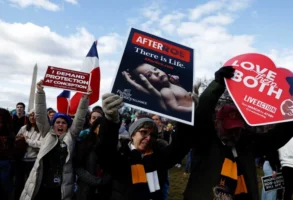
Published January 31, 2021
Editor’s Note: The following essay was first published as the introduction to “Unsafe,” a report from Americans United for Life. It has been reproduced below with slight modifications.
In the fall of 2019, the family of deceased abortionist Ulrich George Klopfer made a ghastly discovery. Cleaning out his Illinois home after his death, they found the medically preserved remains of more than 2,200 unborn children — evidently victims of his decades-long career performing tens of thousands of abortions, which had earned him a reputation as the most prolific abortionist in Indiana.
Later, they uncovered a stash of 165 fetal body parts hidden away in the trunk of one of Klopfer’s cars. Despite a subsequent law-enforcement investigation, we still don’t know the abortionist’s motivation for having kept these grisly trophies; whatever disturbed reasons he may have had for collecting them went with him to his grave.
Perhaps even more striking than the lack of clarity about this horrific discovery was the relative lack of public curiosity about it. Klopfer’s stockpile of corpses received relatively little national attention immediately after local news broke the story, and the entire event passed in and out of the mainstream news cycle in less than a week.
Aside from an opinion article by columnist Ross Douthat, the New York Times published just one brief report the day the news became public. Over the following week, a few major news outlets offered one or two brief articles outlining the basic facts of what had happened, but the bulk of ongoing interest and coverage came from local journalists. Hardly any reporters asked for comment on the matter from politicians, least of all Democrats who support unlimited legal abortion.
Had the remains in Klopfer’s possession been those of 2,411 human adults rather than unborn children, his grotesque hording would have received rapt national attention for months. We would still be discussing it today, remembering him as the most notorious serial killer in American history. But because those little bodies whose lives he so cavalierly destroyed belonged to children still in the womb, most of us closed our eyes and turned away, preferring to pretend we hadn’t seen it.
The natural reluctance to grapple with this kind of horrible incident is perhaps understandable. For a society that spends as much time as we do running from the reality of abortion, such an unvarnished display of its destruction can be difficult to face. But it is important to realize that a significant part of our ignorance about Klopfer was the product of intentional decisions by our mass media, whose reluctance to focus on the story came as no surprise to anyone who regularly follows our debates over abortion.
Though Americans are as divided on abortion policy today as they were in 1973 when the Supreme Court decided Roe v. Wade, the most powerful voices in our increasingly influential mass media have come down almost uniformly on the side of legal abortion. This results in a skewed portrayal of our abortion debate, and indeed of the facts that undergird our deep disagreements about abortion. If you want accurate, complete, unbiased information about abortion — even basic facts such as when, where, and how often it takes place — mainstream media outlets are about the last place you should look.
More often than not, pundits and reporters either ignore the subject of abortion entirely or provide only cursory coverage, as they did with Klopfer’s stash of fetal remains. When they report on abortion at all, they omit essential facts, twist them to weigh more heavily against the anti-abortion argument, or misstate them to make the case for legal abortion appear more favorable.
Americans United for Life’s report “Unsafe” is a powerful antidote to that pervasive, media-induced ignorance. In the report, you’ll find hard data that can be so difficult to locate — the kinds of facts that are crucial to informed, honest, clear-eyed discussions about the reality of abortion in our country.
As much as the seven Supreme Court justices who legalized abortion hoped that their decision in Roe would settle the abortion debate forever, that clearly hasn’t been the case. Almost 50 years later, abortion remains as controversial as ever, arguably the most hotly contested question in American political life. If we ever hope to resolve this contentious battle, we must be ruthless in pursuit of the facts so that we can honestly assess the effects of legal abortion over the past several decades. Those facts and their dissemination are essential to finding ways to alter our abortion policy and protect the least among us — not just the innocent unborn child, but her mother, too.
On this point, let us return to George Klopfer’s story, which really began much earlier than 2019 when those fetal remains were found in his possession. That discovery was not the first time that the abortionist had attracted the attention of local authorities. In 2016, Indiana’s medical-licensing board indefinitely suspended Klopfer’s license after finding that he had violated state law and standard medical procedures while operating three abortion businesses in northern Indiana.
Among other violations, Klopfer had failed to submit terminated-pregnancy reports to the state Health Department and the Department of Child Services after performing abortions on at least two 13-year-old girls. He also admitted to having performed an abortion on a ten-year-old girl who had been raped by her uncle, and he had never reported it to the state.
In the course of operating his businesses, Klopfer routinely failed to ensure that qualified staff were present when patients received or recovered from anesthesia before and after abortion procedures, and he failed to provide proper information and counseling to patients at least 18 hours before performing an abortion, as is required by state law.
Much like the stories behind each statistic in “Unsafe,” the story of Klopfer’s career as a dirty and dangerous abortionist received almost no national coverage. As a result, he received almost no public attention outside the local area — either before or after his family discovered all those body parts in his home. This persistent lack of attention exemplifies the broader lack of public knowledge about the gruesome reality of abortion in our country.
Americans don’t know about Klopfer because abortion proponents and their allies in the media prefer to ignore or hide information that exposes the abortion industry. Most people don’t go searching for facts about abortion because they’d rather not think about it, because they don’t know what to look for, or because they don’t realize they should be looking in the first place.
Far too many Americans don’t know that, in addition to taking unborn human life, abortion is unsafe for women. Most don’t realize that even supposedly “sanitary” abortions pose serious risks to the physical and psychological health of pregnant mothers. Despite Roe’s promise to bring abortion out of the back alley and into the clean light of the modern business, women still suffer severe side effects and sometimes die as the result of abortion procedures — all behind closed doors and away from the front pages of our major newspapers.
Those unpleasant, undercovered realities explain why supporters of abortion are so reluctant to talk about men like Klopfer, his unsafe businesses, and his collection of fetal remains. Most abortionists, of course, don’t collect the remains of the unborn children they’ve killed and store them in molding boxes and old Styrofoam coolers. Instead, they follow common industry practice and dispose of those little bodies along with piles of medical waste.
Is that really any better?
We prefer to ignore abortionists such as Klopfer because their stories force us to confront the brutal reality of abortion, to reckon with the fact that no matter how safe or clean a business might appear to be, every abortion ends with an empty womb and the death of an unborn child.
That is the simple, horrible fact that supporters of legal abortion are desperate to avoid. It’s far easier to defend the right to abortion when it is covered up with phrases such as “women’s health care” or “the right to choose.” Acknowledging that every abortion ends the life of a distinct human being and defending it on those terms is far more difficult and far less popular.
That is why it can be so hard to find facts such as those contained in “Unsafe.” That is why most media outlets will never cover any story that shows how the abortion industry profits from killing the unborn and victimizing their mothers. That is why Klopfer’s victims were buried by the state of Indiana in a mass grave with barely more than a local news story to mark the occasion.
Like the story of Klopfer, of the women who were mistreated in his businesses, of the unborn children whose bodies he stored and those he simply threw away, the realities in “Unsafe” are difficult to face. But we cannot close our eyes to them. We cannot allow ourselves to forget what we’ve seen.
We cannot tell ourselves that George Klopfer’s businesses were an anomaly, that most abortion is sterile and sanitary and safe for pregnant mothers — not when the statistics tell a different story. We cannot avoid forever the thousands of tiny bodies disposed behind businesses each and every day. “Unsafe” offers a glimpse at the truth for anyone willing to look at it. Let us confront without flinching the damage that abortion has wrought in our country, and let us pray for the courage to do what we can to end it.
Alexandra DeSanctis is a staff writer for National Review and a visiting fellow at the Ethics and Public Policy Center.





